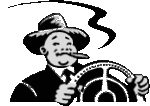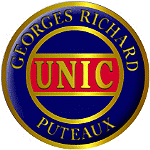

|

Cars A to Z
\ Fahrzeuge von A bis Z

|
| UAZ |
 |
|
UAZ (УАЗ), Ulyanovsky Avtomobilny Zavod is an automobile manufacturer based in Ulyanovsk, Russia which makes SUVs, buses and trucks. Production started in 1941.
In 1941, after the start of Great Patriotic War, Stalin's government made every effort possible to try to save Soviet industry from being captured by the German army. So, in 1941, because of rapid advances by the Germans on Moscow, a decision was made to relocate ZIS - a Moscow car and freighter manufacturing plant - further away from the front line. Such a place was Ulyanovsk, a town in Volga region with existing infrastructure and skilled workers, but out of reach of German army. At that time, the plant was considered a subsidiary of ZIS. By 1942, the production of artillery shells and cars began.
In 1943, when the prospect of Germans winning the war was less likely, a decision was made to separate the relocated plant from ZIS. This was a part of general after-war policy conducted by Stalin's government in which relocated plants were separated into different units, since all the required buildings had already been erected. The existing plants before relocation were filled with (often - German) equipment, thus bursting the industry.
A logical choice for the newly created plant was to produce military and paramilitary cars, mostly due to its distance from the border. Therefore, in mid-1950es the production of the only Soviet offroad car, GAZ-69, was moved to Ulyanovsk. This car marked a beginning of a famous line of offroad vehicles manufactured by the plant.
http://en.wikipedia.org/w/index.php?title=UAZ&oldid=100778543
|
|
|
|
|
|
 ^ top ^ top |
|
| ULTIMA |
 |
|
ULTIMA HISTORY IN BRIEF
1983:
Lee Noble, acclaimed automotive engineer and designer, sets up Noble Motorsport Ltd and launches the Ultima Mk1.
The Ultima Mk1 had a square tube space frame chassis, Ford Cortina front uprights/brakes/steering, Austin Princess radiator and Renault front uprights/brakes on the rear. The V6 engine and transmission were taken from a Renault 30.
1984-89:
The Ultima Mk2 was developed which replaced the problematic Renault rear suspension with Noble Motorsports own alloy uprights which were machined to accept a Renault wheel bearing and Lancia Beta rear brakes.
1989-90:
Other customers copy Ted Marlow’s philosophy and fit small block Chevrolet V8 engines into their Ultima
racecars.
Chevrolet V8 powered Ultima cars dominate races for five years. Taking championship victories every season.
Ultima cars hold the outright lap record for any car on road tyres (race regulations stipulated only road tyres could be used) on every circuit they race on.
Ted Marlow’s Ultima Mk2 leads an Ultima Mk3 and Ultima Spyder prototype into the Mallory Park hairpin on lap one and go on to record yet another Ultima 1-2-3
victory.
1991:
Ultima effectively banned from racing for being too quick and therefore deemed unfair to other competitors.
|
|
|
|
|
 ^ top ^ top |
|
| UMM |
 |
|
UMM (União Metalo-Mecânica) is a Portuguese metal works factory and a former automobile manufacturer based in Lisbon. It was founded in 1977 with the purpose of manufacturing 4wd vehicles for agricultural, industrial and utility applications.
The UMM four wheel drive design is derived from a prototype created by the French engineering firm
Cournil, called Entrepreneur. The Cournil Entrepreneur's building rights were acquired by the Portuguese company União Metalo-Mecânica, part of the
Mocar group.
They became known for their reliability, especially when in a Paris-Dakar rally the team was able to finish with all the cars that started. Many UMMs are still in use by utilities in Spain and Portugal and also by the
"Guarda Nacional Republicana" (Portuguese Gendarmerie), fire service and military, although the majority of their customers were private individuals. They are also popular in France and Angola.
UMM stopped building cars for private customers in 1993, but kept on taking large orders from military and utility services until 1996. Custom orders are still accepted. The most famous UMM is probably the one who transported Pope John Paul II in one of his visits to Portugal.
An updated version was announced in 2000, powered by the Citroen XM's 2.1 L Turbo Diesel engine. This engine was less noisy and more torquey at low speed. Several options were available, including air conditioning and GPS. Price was meant to be equivalent to a Land Rover Discovery with similar finishings. However, the company had no capital to invest on its development.
http://en.wikipedia.org/w/index.php?title=UMM_%28Uni%C3%A3o_Metalo-Mec%C3%A2nica%29&oldid=95135380 |
|
|
|
|
 ^ top ^ top |
|
| UNIC |
 |
|
Unic was a French car manufacturer firm founded by
Georges Richard in 1906 after having left Richard-Brasier. Société anonyme des automobiles UNIC was established in Puteaux with two-cylinder and four-cylinder models.
The 1943 cm³ 12 CV (9 kW) four-cylinder model (used maily as a taxi) was extremely successful and survived in production for nearly 20 years. (The engine was enlarged later to 2120 cm³.) During World War I, taxis made by the company participated in Marne operation. After WW I, a new four-cylinder (1847 cm³) was offered, along with the taxis. Truck production started in that era. During the 1920's, a 1997cc sports model was marketed and in some models sleeve valve engines were used. Georges Richard died in 1922. In the 1930's, there were two eight-cylinder models. Passenger car production ceased in 1938.
In 1952, the firm was taken over by Simca, headed by Pigozzi, who wanted a commercial vehicle production unit. Trucks of this period are commonly referred to as
Unic-Simca trucks. In 1956 the French arm of the Swiss truck manufacturer Saurer was taken over. In 1966 Unic joined the Fiat Group.
UNIC-FIAT S.A. was founded in 1974. In 1975 a holding company named
IVECO was established covering truck and bus brands such as Fiat, OM, Lancia, UNIC and Magirus. In 1976 UNIC-FIAT S.A. became UNIC S.A.. IVECO VILLEJUIF (V.I.S.) was privatised in 1985. In 1992
IVECO UNIC S.A. changed its name to IVECO FRANCE S.A.. In 2003, the company's headquarters moved from Villejuif to Boissy St Léger, where a second facility was established in 1995.
http://en.wikipedia.org/w/index.php?title=Unic&oldid=99620806 |
|
|
|
|
 ^ top ^ top |
|
UNICAR
Opperman |
 |
|
S E Opperman was a tractor manufacturer in England and after he saw the Bond decided to build his own four wheel microcar at a factory in Elstree, Hetfordshire.
The first model was the Model "T" Unicar, designed by Laurie Bond and built between 1956 and 1959. It looked like a miniature two door saloon with 2+2 seating and was the cheapest car at the 1956 London Motor Show, but it was even cheaper if you built it as a kit when it could be had without engine for £170. A complete car cost £400. The body was made in fibreglass mounted on a steel tube chassis and had neither bonnet nor boot lid. The engine was placed in the middle of the rear seat giving two small seats on either side of the engine. Since it had no differential for the rear wheels they were placed close together. The front suspension was independent using coil springs and struts and at the rear trailing arms were used. The brakes were mechanically operated. It was powered by a 328 cc
Excelsior twin-cylinder, air-cooled, two-stroke engine giving 18 bhp and a top speed of 45 mph. Some early models had an Anzani engine. About 200 were made.
The only other Opperman was the Stirling, but only two were made, built between 1958 and 1959. Much more stylish than the Unicar the first had a larger 424 cc 25 bhp
Excelsior engine and the second had a Steyr 500 cc unit. The brakes were now hydraulic and the rear wheels further apart. The launch of the Mini in 1959 wiped out the rationale for the Opperman and the Stirling never went into full production.
http://en.wikipedia.org/w/index.php?title=Opperman&oldid=90184040 |
|
|
|
|
 ^ top ^ top |
|
| UNIMOG |
 |
|
The Unimog (from the German "UNIversal-MOtor-Gerät", meaning "universal motor machine/equipment") is a range of trucks produced by
Mercedes-Benz (now a division of DaimlerChrysler AG). The first model was designed shortly after WWII, originally to be used as slow-moving tractors for Germany's turnip harvest.
New Unimogs can be purchased on all major continents. Unimogs are common in Western Europe, where they are used as snow plows, military vehicles, expedition campers, construction equipment, agricultural implements, and municipal equipment carriers.
In 2006, Unimogs can be purchased in either of two series. There is a medium series 405, also known as the UGN
("Geräteträger" or equipment carrier), which is available in the
U300-U500 model. There is also the heavy series 437, also known as the UHN
("Hochgeländegängig" or highly mobile cross country), which is available as the
U3000-U5000 model.
In September of 2006, DaimlerChrysler presented the new small Unimog U20 at the IAA trade fair in Hannover, Germany. It will be available in Germany in late 2007, is based on a shortened U 300 frame and uses a smaller cabin.
http://en.wikipedia.org/w/index.php?title=Unimog&oldid=100415314 |
|
|
|
|
 ^ top ^ top |
|
| UNIPOWER |
 |
|
The Unipower GT was a British specialist sports car first shown at the January
1966 Racing Car Show, and produced by truck maker Universal Power Drives Ltd in
Perivale, Middlesex and later by U.W.F. Automotive in London until production ceased in early 1970, by which time around 75 are believed to have been made, including about 15 built by U.W.F..
The car was based on BMC Mini mechanical components with the transverse engine and gearbox unit mounted in a mid-engine configuration. A strong spaceframe chassis with integral roll-over protection was bonded to a fibreglass body to produce a light yet rigid structure, with all-round independent wishbone suspension. Combining light weight, a low centre of gravity and low aerodynamic drag from a body that measured just 40.5 inches high, the Unipower offered very good performance and excellent road holding and handling characteristics. Available with the 998cc Mini-Cooper or more potent 1275cc Cooper "S" engine, this latter version was reported to be capable of 0-60mph in around 8 seconds and to have a maximum speed of almost 120mph.
A design was produced for a larger Unipower but this did not go into production with the original makers instead eventually evolving into the
AC ME3000.
Unipower also made a limited number of the "glass box" Quasar-Unipower
cars.
http://en.wikipedia.org/w/index.php?title=Unipower&oldid=76679851
|
|
|
|
|
 ^ top ^ top |
|
| UNKNOWN |
Unbekannte Fahrzeuge
Help to indentify ! |
|
|
|
|
|
 ^ top ^ top |
|
|
|

